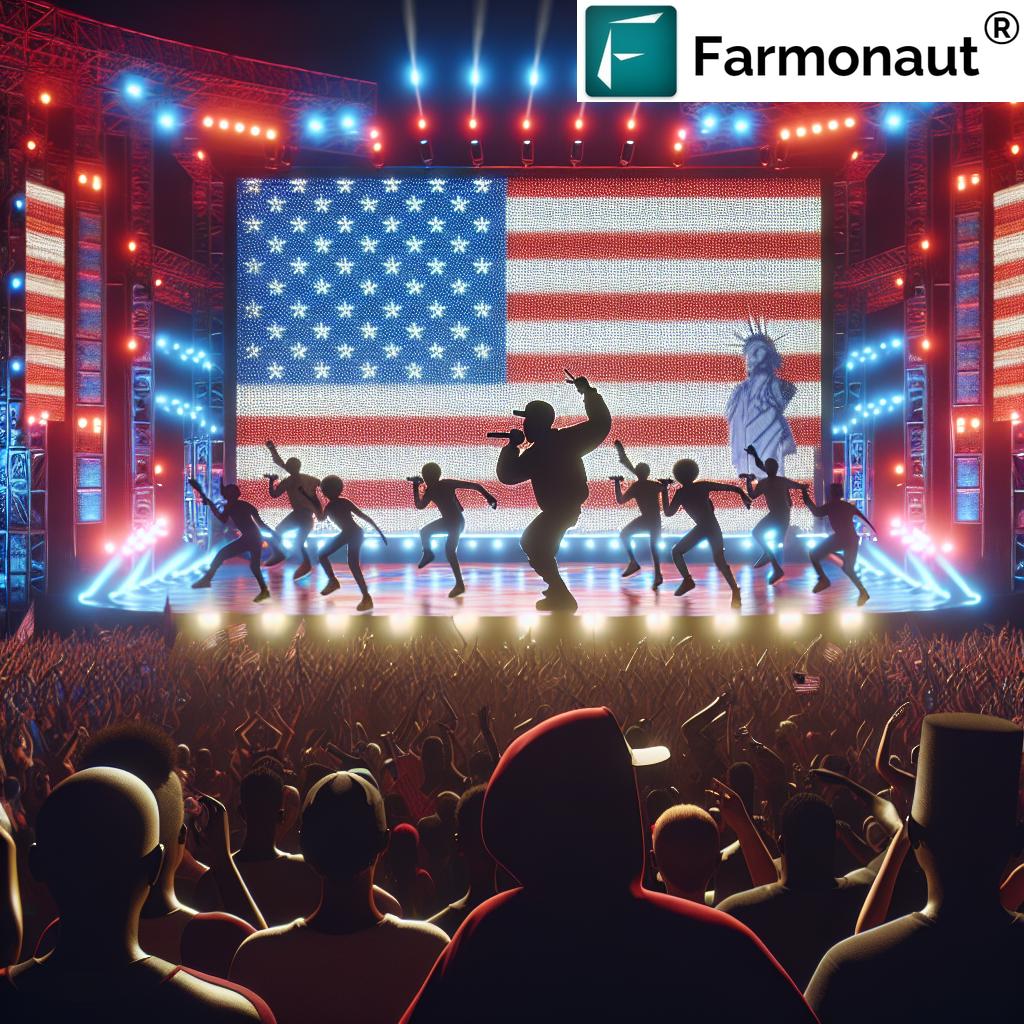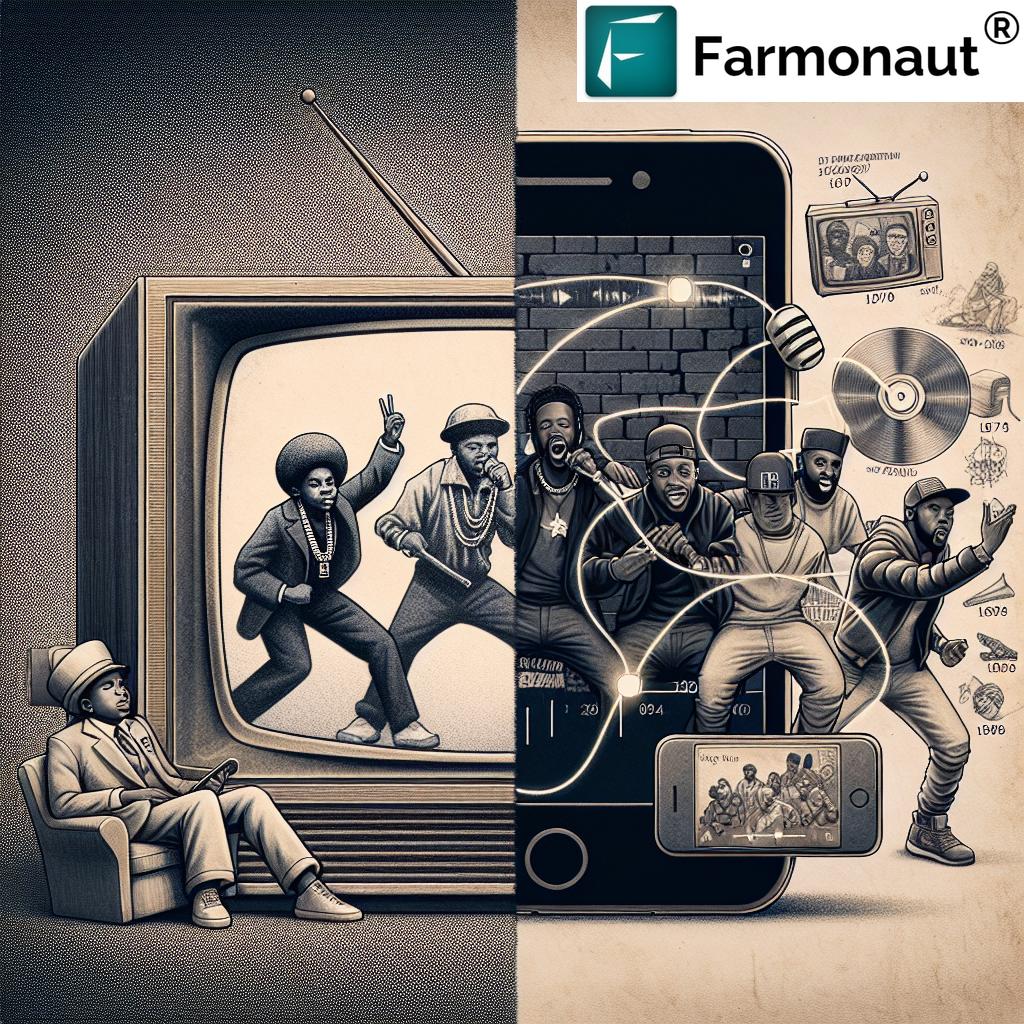Groundbreaking Super Bowl Halftime Show: Hip-Hop Activism Meets Cultural Symbolism in American Media

“The 2022 Super Bowl halftime show marked the first time a solo rapper headlined the iconic event in its 56-year history.”
In the realm of American media and popular culture, few events capture the nation’s attention quite like the Super Bowl halftime show. On February 10, 2025, we witnessed a groundbreaking moment in music history as Kendrick Lamar became the first solo rapper to headline this iconic spectacle. This performance was not merely entertainment; it was a powerful fusion of hip-hop activism and cultural symbolism that resonated deeply with audiences across America and beyond.
As we delve into the significance of this historic performance, we’ll explore how Lamar’s artistry transcended the boundaries of traditional entertainment, weaving together themes of race, power, and societal issues in contemporary America. This blog post will analyze the intricate layers of symbolism, the political commentary embedded within the performance, and the broader implications for African American representation in media.
The Evolution of Hip-Hop in Super Bowl Halftime Shows
Before we dive into the details of Lamar’s groundbreaking performance, it’s essential to understand the context of hip-hop’s journey in Super Bowl halftime shows. Here’s a timeline that illustrates the progression of hip-hop activism and cultural representation in this prestigious event:
| Year | Artist(s) | Key Themes | Cultural Impact |
|---|---|---|---|
| 2004 | P. Diddy, Nelly | Mainstream hip-hop introduction | Opened doors for hip-hop artists in halftime shows |
| 2011 | The Black Eyed Peas | Pop-infused hip-hop, technology | Broadened appeal of hip-hop to wider audiences |
| 2013 | Beyoncé (featuring Destiny’s Child) | Female empowerment, Black pride | Sparked discussions on race and feminism in pop culture |
| 2016 | Coldplay, Beyoncé, Bruno Mars | LGBTQ+ rights, Black Lives Matter | Raised awareness of social justice issues on a global stage |
| 2020 | Jennifer Lopez, Shakira | Latina representation, immigration | Celebrated diversity and highlighted immigrant contributions |
| 2022 | Dr. Dre, Snoop Dogg, Eminem, Mary J. Blige, Kendrick Lamar | West Coast hip-hop legacy, racial equality | Showcased hip-hop’s cultural dominance and social influence |
| 2025 | Kendrick Lamar | Race and power in America, censorship, hip-hop rivalry | Redefined the role of hip-hop activism in mainstream media |
This timeline demonstrates the gradual but significant integration of hip-hop into one of America’s most-watched events, culminating in Kendrick Lamar’s solo headline performance in 2025.
Kendrick Lamar’s Unapologetic Performance
Lamar’s performance was described as “unapologetically Black,” a phrase that encapsulates the bold and uncompromising nature of his artistic expression. By utilizing this massive platform to address themes of race and power in contemporary America, Lamar effectively merged his artistry with activism, creating a performance that was both entertaining and profoundly meaningful.
Key elements of Lamar’s performance included:
- Powerful visual narratives that spoke to the African American experience
- Lyrical content that addressed systemic issues in society
- Choreography that incorporated elements of traditional African dance
- Costume design that paid homage to Black cultural icons
These elements combined to create a spectacle that was not only visually stunning but also rich in cultural significance and political commentary.
The Samuel L. Jackson Moment: Censorship Personified
One of the most striking aspects of Lamar’s performance was the appearance of iconic actor Samuel L. Jackson, who took on the persona of Uncle Sam. This creative choice served as a powerful metaphor for censorship in America, highlighting the constraints often faced by artists, particularly within the hip-hop genre.
Jackson’s portrayal of Uncle Sam wasn’t just a clever costume choice; it was a multi-layered symbol that:
- Represented the authoritative voice of America
- Highlighted the tension between artistic expression and societal norms
- Challenged viewers to consider the role of censorship in shaping cultural narratives
The interaction between Lamar and Jackson’s Uncle Sam character created a compelling visual dialogue about freedom of speech, artistic integrity, and the power dynamics at play in American society.
The Flag Formation: A Symbol of Unity and Struggle
“The performance featured a dramatic flag formation with 100+ dancers, symbolizing unity and cultural representation in American media.”
Perhaps the most visually striking moment of the performance was the dramatic flag formation created by Lamar’s dancers. This powerful image served as a potent symbol of national identity and the complex relationship between African Americans and the broader American narrative.
The flag formation:
- Represented the diversity within American culture
- Highlighted the contributions of African Americans to the nation’s fabric
- Challenged viewers to consider what it means to be American in the 21st century
By incorporating this symbol into his performance, Lamar effectively used the language of patriotism to make a nuanced statement about race, identity, and belonging in America.
Hip-Hop Rivalry Meets Political Commentary
Interestingly, Lamar’s performance wasn’t solely focused on broad societal issues. The inclusion of his track “Not Like Us” during the show highlighted his ongoing disputes within the rap community, particularly his well-known feud with fellow artist Drake. This aspect of the performance demonstrated how personal rivalries within hip-hop can intersect with larger cultural and political narratives.
The inclusion of this track served multiple purposes:
- It maintained the authenticity of hip-hop culture within the mainstream setting
- It showcased the competitive nature of rap as an art form
- It demonstrated how personal conflicts can be used as a metaphor for broader societal tensions
By weaving together elements of personal rivalry and political commentary, Lamar created a performance that was as much about individual artistic expression as it was about collective struggle.
Expert Analysis: George Washington University Weighs In
To gain deeper insights into the significance of Lamar’s performance, we turn to experts from George Washington University. Their analysis helps us understand the balance between political statement and hip-hop spectacle, and how Lamar’s artistry serves as a conduit for discussing systemic issues within society.
Imani M. Cheers: Digital Storytelling and Representation
Imani M. Cheers, an associate professor and award-winning digital storyteller, offers a unique perspective on Lamar’s performance. Her work, which focuses on issues of the African diaspora and critiques the representation of Black women in media, provides valuable context for understanding the cultural significance of this event.
According to Cheers, Lamar’s performance was:
- A profound statement on the state of race relations in America
- A clever commentary on the internal dynamics of hip-hop culture
- A showcase of innovative digital storytelling techniques in live performance
Cheers emphasizes that Lamar’s unique style positions him distinctly in the music industry, affirming his status as “Not Like Us” – a reference to both his artistic uniqueness and his commentary on societal otherness.
Loren Kajikawa: Music, Race, and Politics in America
Loren Kajikawa, who chairs the music program at the Corcoran School of the Arts & Design at GWU, brings his expertise on the intersection of music, race, and politics in America to the analysis of Lamar’s performance. As the author of “Sounding Race in Rap Songs,” Kajikawa is well-versed in the complexities of rap music, especially relating to racial representation in sound and lyrics.
Kajikawa’s insights help us understand:
- How the musical elements of Lamar’s show communicate messages about societal issues
- The historical context of using popular music as a vehicle for social commentary
- The evolution of hip-hop as a form of cultural expression and political activism
Through Kajikawa’s lens, we can appreciate how Lamar’s performance fits into a larger tradition of musicians using their art to address social and political issues.
The Impact on African American Representation in Media
Lamar’s groundbreaking performance has significant implications for African American representation in media. By taking center stage at one of the most-watched television events in the United States, Lamar has:
- Challenged traditional notions of what constitutes “mainstream” entertainment
- Provided a platform for authentic Black voices and experiences
- Demonstrated the power of hip-hop as a tool for social commentary and cultural critique
This performance may well serve as a turning point in how African American artists are perceived and presented in major media events, potentially opening doors for more diverse and nuanced representations in the future.
The Role of Digital Storytelling in Modern Activism
Lamar’s performance wasn’t just musically and visually impressive; it was also a masterclass in digital storytelling. By leveraging advanced technology and innovative production techniques, Lamar was able to create a multi-layered narrative that resonated with audiences both in the stadium and watching at home.
Key aspects of digital storytelling in Lamar’s performance included:
- Use of augmented reality to enhance visual symbolism
- Integration of social media elements to encourage real-time audience engagement
- Incorporation of historical footage to provide context for the performance’s themes
This approach to performance demonstrates how digital storytelling can be used as a powerful tool for activism, allowing artists to create immersive experiences that educate and inspire audiences.
The Future of Hip-Hop Activism in Mainstream Media
Lamar’s Super Bowl halftime show may well be a watershed moment for hip-hop activism in mainstream media. By successfully blending entertainment with social commentary on such a massive stage, Lamar has potentially paved the way for more artists to use high-profile platforms as vehicles for important messages.
Looking forward, we might expect to see:
- More hip-hop artists headlining major events and using them as platforms for activism
- Increased integration of social and political themes in mainstream entertainment
- Greater acceptance of hip-hop as a legitimate form of cultural and political expression
As we reflect on this groundbreaking performance, it’s clear that Kendrick Lamar has not only made history but has also set a new standard for what is possible when art, activism, and mainstream media converge.
Conclusion: A Cultural Milestone
Kendrick Lamar’s Super Bowl halftime show was more than just a musical performance; it was a cultural milestone that will be remembered for years to come. By seamlessly blending entertainment with powerful social commentary, Lamar demonstrated the potential of hip-hop as a force for change in American society.
This performance:
- Challenged viewers to confront important issues of race and power
- Showcased the evolution of hip-hop as an art form and a vehicle for activism
- Set a new standard for what is possible in mainstream entertainment
As we move forward, it will be fascinating to see how this groundbreaking performance influences future artists and shapes the landscape of American media and popular culture.
FAQs
- Q: Why was Kendrick Lamar’s Super Bowl halftime show considered groundbreaking?
A: It was the first time a solo rapper headlined the show, and Lamar used the platform to address important social and political issues through his performance. - Q: What were some of the key themes in Lamar’s performance?
A: The performance addressed themes of race, power dynamics in America, censorship, and hip-hop culture. - Q: How did Samuel L. Jackson’s appearance contribute to the performance?
A: Jackson portrayed Uncle Sam, serving as a metaphor for censorship and authority in America, adding depth to the performance’s commentary on freedom of expression. - Q: What was the significance of the flag formation in the show?
A: The flag formation symbolized unity, diversity, and the complex relationship between African Americans and national identity. - Q: How did Lamar’s performance impact African American representation in media?
A: It challenged traditional notions of mainstream entertainment and provided a platform for authentic Black voices and experiences on a massive scale.

As we conclude our analysis of this groundbreaking performance, it’s clear that Kendrick Lamar has set a new standard for what is possible when art, activism, and mainstream media converge. His Super Bowl halftime show will undoubtedly be remembered as a pivotal moment in the history of hip-hop and American popular culture.
For those interested in exploring more about cultural symbolism and digital storytelling in music, we recommend checking out resources from George Washington University’s music and media studies programs. Additionally, for a deeper dive into the intersection of technology and cultural expression, consider exploring innovative platforms like Farmonaut, which demonstrates how cutting-edge technology can be applied to various fields, including agriculture and environmental monitoring.
While Farmonaut’s focus is on agricultural technology, its innovative approach to data visualization and analysis shares some parallels with the digital storytelling techniques used in modern music performances. By leveraging satellite imagery and AI, Farmonaut provides valuable insights to farmers, much like how artists like Lamar use technology to convey powerful messages to their audiences.
For those interested in exploring Farmonaut’s technology:
As we continue to witness the evolution of hip-hop and its influence on American culture, it’s clear that technology will play an increasingly important role in how messages are conveyed and received. Whether it’s through groundbreaking musical performances or innovative agricultural solutions, the power of digital tools to drive change and foster understanding cannot be underestimated.
















